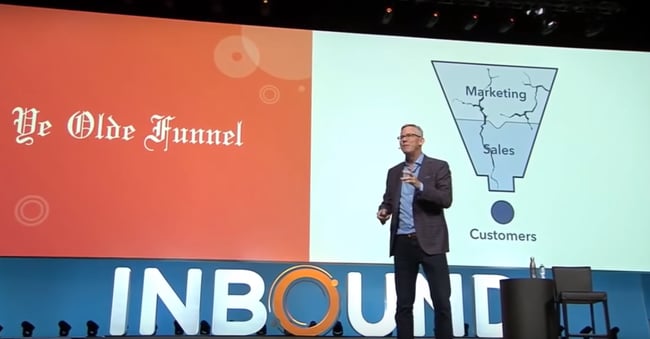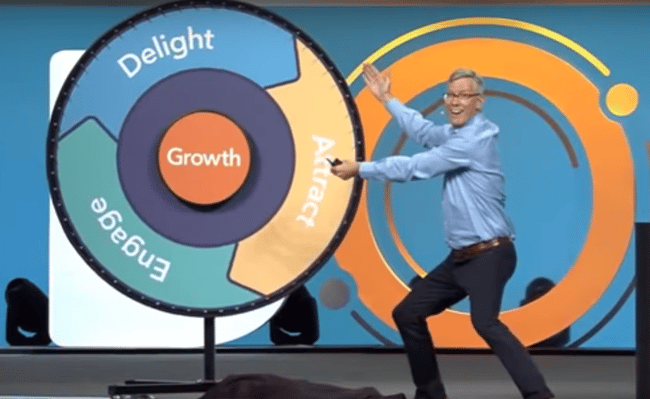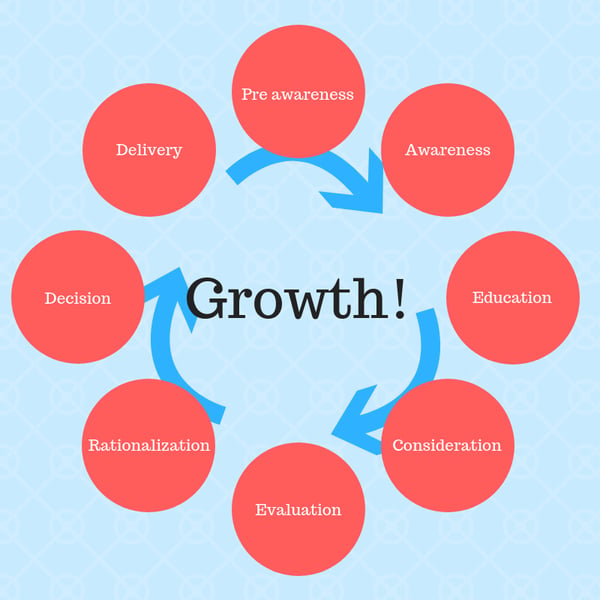Depending on who you talk to about their experience at Inbound 2018, you will get a variety of answers, due to the wide range of topics covered from the benefits of AI in search to understanding the value of data science in marketing.

But what stood out to me was how Brian Halligan and Dharmesh Shah from HubSpot shook up the marketing world, again, with their keynote about abandoning the typical marketing funnel.

Brian explained this older marketing funnel isn’t optimized for growth because growth starts with retention.
As marketers, we need to invest more into our customers to retain business and convert our clients into brand advocates. The best business is referral business, because these prospects are already bought in to your product or service from a third party, making it an easy sell for your sales reps.
To replace the traditional marketing funnel, Brian suggested a different model, called the flywheel.

This flywheel is a continuous loop of attracting new business, engaging prospects, and delighting customers.
Brian and Dharmesh’s keynote set the stage, as the rest of the conference sessions were geared toward this same message of great customer service and client retention.
Great! Where do I start?
So I need to delight customers. Great,where do I start?
Data. Data. Data.
Start by researching your customers. One of the best takeaways from Inbound18 was you have to understand people. In this era of information the consumer is in control, so meet them on their turf.

I picked up some great tips on how to conduct better audience research from Dustin Clark, the Digital Marketing Director at Element Three:
Information worth gathering:
- Contextual language cues.
- How are customers talking about their pain points and how can you address them?
- Types of preferred content.
- How do your customers prefer to digest content? Video, blog, infographic, other formats?
- Favorite topics and interests.
- What type of social circles do they run in? What types of sites do they frequently visit?
Where to find this information:
- Industry forums.
- Social profiles.
- Search engines.
- User interviews.
- Conferences.
- Customer Surveys
- Occupational Outlook handbook.
Customer data is the foundation upon which you will build out the rest of your marketing strategy. You can never gather too much data.
Take a look at your current processes within your own organization and see what you can already gather and what tools you may need to better understand your customers.
Awesome! What do I do with this information?
Now that you have gathered all the information you can from your clients, how do you apply this knowledge to attract similar customers? This is where targeted marketing efforts come in to play.
Most companies have a variety of lead generation and marketing efforts, including:
- PPC and display advertising.
- Blog content.
- Chatbots.
- Webforms.
- Webinars.
- Trade shows.
- Social media.
- Referral programs.
All of these activities can be optimized to target your ideal clients.
Use your audience research to develop or modify your buyer personas, then apply that information to all of your marketing efforts to target the ideal client.
“The secret to 10x growth is in the data and listening to customers.” - Tara Robertson, Director of Marketing Strategy and Operations at Sprout Social
Regardless of the growth in marketing automation tools, we as marketers need to understand that nothing we do is simply “set it and forget it”. Our marketing efforts need a human touch to constantly review, tweak, and improve each process — this is how growth happens.
Okay. But what about growing pains?
Mike Lieberman, CEO and Chief Revenue Scientist at Square 2 Marketing explained in a session that prospects are over-saturated with content leading to a lack of action.
How many times have you had a prospect say “This is great, we’ll think about it and get back to you,” and you never hear from them again? Maybe they went with another company or maybe they never pulled the trigger on a solution. Prospects can become overwhelmed with the vendor selection process, especially when companies are all promising the same thing.

It is important to understand the key to company growth isn’t creating a better product than the competition, but rather servicing the client better than the competition.
86% of consumers are willing to pay up to 25% more for better customer service. (Oracle)
It is crucial to focus on retention over acquisition if you are trying to grow your organization.
In his session, Mike created a great visual that fully adopts the new flywheel method of the buyer's journey, and takes it even further.

I recreated the image here, so it is different colors, but the journey is the same. It is equally important to understand which departments are responsible for each section of the buyer’s journey.
Mike breaks it down like this:
Pre-awareness
- PPC and advertising.
- Managed mostly by your marketing team, supported by feedback from sales team.
Awareness
- Blog and website information.
- Managed by the marketing team.
Education
- Website, product information, and landing pages.
- Managed by your marketing team.
Consideration
- Webforms and converting pages.
- Managed by your marketing and sales teams.
Evaluation
- Sales connects with the prospect to educate them on your process and why your solution is the best fit for them.
Rationalization
- Sales rep creates a pitch for the prospect, helping them visualize what it looks like to work with your company.
Decision
- Analyst reviews conversion rates and close rates for sales to make sure you are hitting your revenue goals and attracting the right prospects.
Delivery
- Customer success team cultivates brand advocates and asks for referrals.
After the “Delivery” stage the cycle begins again.
Every part of this cyclical buyer’s journey can be broken down and optimized. Make sure you have a process to optimize each step the customer takes when working with your company.
Key Takeaways
Earn the trust of your customers. It's important to be human in a world of automation — listen to your customers and acknowledge their pain points.
Inbound 2018 was my first time at an Inbound conference, and it was a great experience. Thousands of marketers were sharing ideas on how to build long-lasting, sustainable organizations rather than chasing shortcuts to success.
Here are some great points to remember:
- Growth begins with retention. Provide the best customer service in your industry and you can grow your best prospect channel — referrals.
- Audience research is imperative to growth. Gather as much data as possible to optimize your buyer’s journey.
- Prospects don’t want to be sold, they want to make an informed decision. Craft your sales cycles around information and education.
Thanks for reading, and if you're considering attending Inbound next year I would highly recommend it!

